|
October 1, 2016 - No. 38
Supplement
For Your
Information
Resistance at
Standing Rock
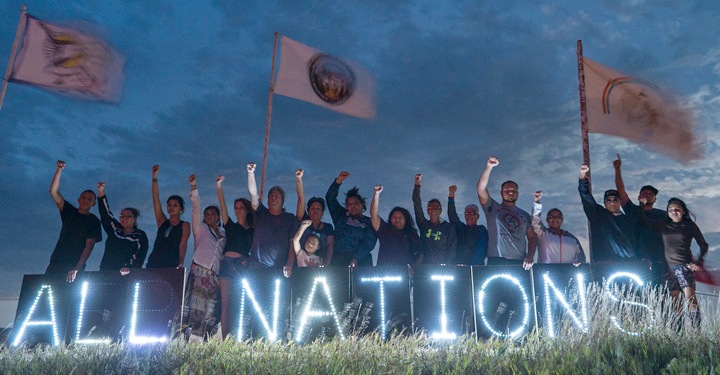
• Background
on Standing Rock
Struggle
• Excerpts from Standing Rock Sioux
Tribe Resolution
Opposing Dakota Access Pipeline
• Violations of Federal Law in
Pipeline Approval
• We Are Still Here. We Are Still
Fighting for Our Lives on Our Own Land
- LaDonna Brave Bull Allard, Standing Rock Sioux -
• We Are Protectors, Defending the
Land And Water
- Iyuskin American Horse, Canyon Ball, North Dakota -
• The Vicious Dogs of Manifest
Destiny Resurface in North Dakota
- Jacqueline Keeler -
For Your
Information -- Resistance at Standing
Rock
Background on Standing Rock Struggle
April 2016
Standing Rock Sioux Tribal members began protesting the
1,885-kilometre, four state, Dakota Access Pipeline
construction by setting up the Sacred Stone Camp (sacredstonecamp.org) along the
banks of Lake Oahe in North Dakota. They are organizing to protect and
ensure safe water for millions, as the pipeline crosses both the
Missouri River and Lake Oahe. The Standing Rock Sioux Tribe has been
locked in a battle to stop the Dakota Access Pipeline from impacting
its cultural, water, and natural resources. The pipeline will transport
as much as 570,000 barrels of oil each day from North Dakota to
Illinois. The Army Corps of Engineers green-lighted several sections of
the process without fully satisfying the National Historic
Preservation Act, various environmental statutes, and its trust
responsibility to the Standing Rock Sioux Tribe.
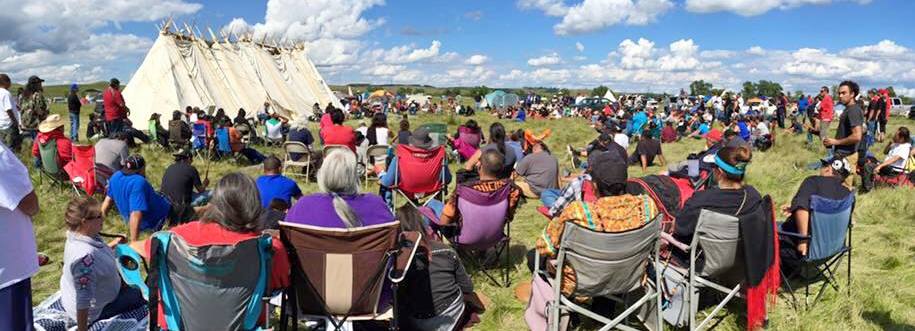
Camp meeting at Sacred Stones camp of Standing Rock Sioux.
This is another chapter in the long history of the U.S.
federal government granting the construction of potentially hazardous
projects near or through tribal lands, waters, and cultural places
without consulting the tribe. The current proposed pipeline route
crosses under Lake Oahe, just 800 metres up from the Standing Rock
Sioux Reservation. It is not a question of if the pipeline will leak,
but when. This is evident from recent oil spills, including the release
of more than 300,000 litres of oil near Tioga, North Dakota in October
2013; nearly 200,000 litres of oil released into the Yellowstone River
upstream from Glendive, Montana resulting in the shutdown of the
community water system for 6,000 residents in January 2015; and the
release of 3.79 million litres of tar sands crude into Michigan's
Kalamazoo River in July 2010.
August 2016
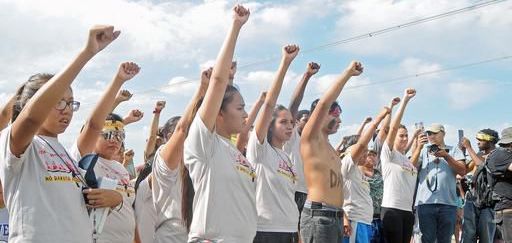
Standing Rock Sioux youth run from North Dakota to Washington DC.
Youth from the Standing Rock Sioux tribe run from their
tribal lands in North Dakota to Washington, DC to call for a halt to
the DAPL and respect for their treaty rights and for the water and
Mother Earth.
The Standing Rock Sioux Tribe filed suit in federal
district court in Washington, DC against the U.S. Army Corps of
Engineers, which is the primary federal agency that granted the permits
needed for construction of the pipeline.
September 2016
The Sacred Stone Camp
supporters
grow by the thousands with 280 tribes represented. National attention
grows from the broad and increasing support among Indigenous peoples
and many others.
- The Dakota Access Pipeline guards, including
notorious G4S, known for their inhumane treatment of women and children
in detention centres and of Palestinian youth, unleash attack dogs on
American Indian water protectors, including women and children.
- North Dakota Governor activates the National Guard to
protect the pipeline instead of the indigenous peoples, including
checkpoints
with armed guardsman requiring all to stop. It was also reported
that members of Red Warrior camp have been arrested and that law
enforcement check points are photographing people, perhaps to
make mass arrests later. Activists are urged to avoid the check
points.
- September 9, Federal court denies the Standing Rock
Tribe's
request for an injunction. However, a joint statement from the
Department of Justice, the Department of the Army, and the
Department of the Interior asked for construction to voluntarily
be ceased on federally controlled lands.
- The Sacred Stone Camp remains strong and united,
preparing
to remain through the winter. Support and actions also continue
across the country, including demonstrations, gathering supplies
and funds, and making the journey to the camp to lend a hand.
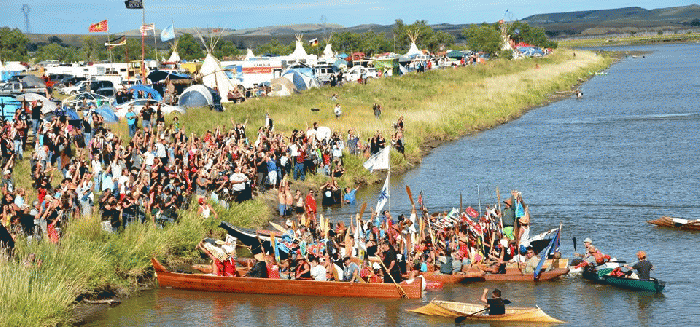

Excerpts from Standing Rock Sioux Tribe Resolution
Opposing
Dakota Access Pipeline
WHEREAS, the Standing Rock Indian Reservation was
established as a permanent homeland for the Hunkpapa, Yanktonai,
Cuthead and Blackfoot bands of the Great Sioux Nation;
and
WHEREAS, the Dakota Access Pipeline threatens public
health
and welfare on the Standing Rock Indian Reservation; and
|
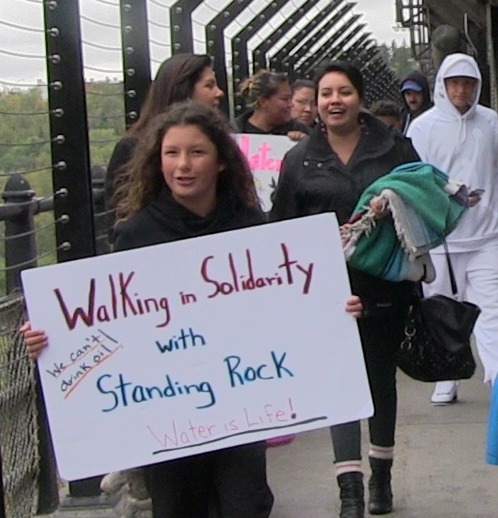
Edmonton, September 11, 2016.
|
WHEREAS, the Standing Rock Sioux Tribe relies on the
waters
of the life-giving Missouri River for our continued existence,
and the Dakota Access Pipeline poses a serious risk to Mni Sose
and to the very survival of our Tribe; and
WHEREAS, the horizontal direction drilling in the
construction of the pipeline would destroy valuable cultural
resources of the Standing Rock Sioux Tribe; and
WHEREAS, the Dakota Access Pipeline violates Article 2
of the
1868 Fort Laramie Treaty which guarantees that the Standing Rock
Sioux Tribe shall enjoy the "undisturbed use and occupation" of
our permanent homeland, the Standing Rock Indian Reservation;
NOW THEREFORE BE IT RESOLVED, that the Standing Rock
Sioux
Tribal Council hereby strongly opposes the Dakota Access
Pipeline; and
BE IT FURTHER RESOLVED, that the Standing Rock Sioux
Tribal
Council call upon the Army Corps of Engineers to reject the river
crossing permit for the Dakota Access Pipeline....

Violations of Federal Law in Pipeline Approval
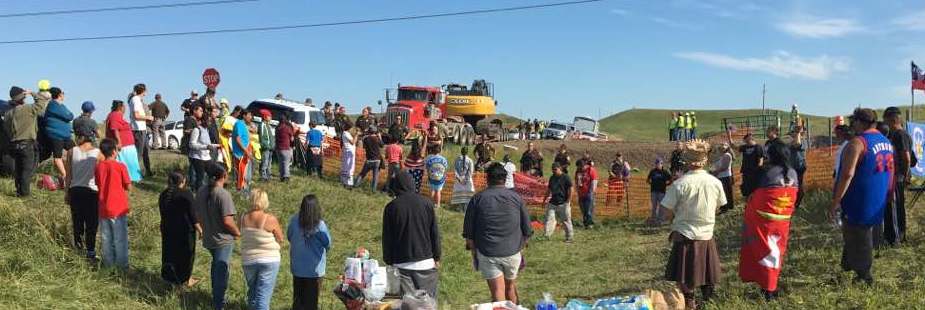
The federal government, including the Department of
Justice and Army Corps of Engineers, gave the green light for
construction of the Dakota Access Pipeline, from North Dakota to
Illinois, despite violations of federal law and treaty rights by
the energy monopolies involved. While currently there has been a
temporary halt to some sections of the pipeline -- as a result of
the firm stand of the Standing Rock Sioux and hundreds of other
tribes and organizations to protect the water and scared burial
grounds -- the government has not called for ending construction
of the pipeline.
Below are treaty rights and federal laws being violated.
Fort Laramie Treaty of April 29, 1868: The
Dakota
Access Pipeline violates Article 2 of the 1868 Fort
Laramie Treaty which guarantees that the Standing Rock Sioux
Tribe shall enjoy the "undisturbed use and occupation" of their
permanent homeland, the Standing Rock Indian Reservation. The
U.S. Constitution states that treaties are the supreme law of the
land.
Executive Order 12898 on Environmental Justice:
All agencies must determine if the proposed project disproportionately
impacts Tribal communities or other minority communities. The Dakota
Access Pipeline was originally routed to cross the Missouri River north
of Bismarck. The crossing was moved to "avoid
populated areas," so instead of crossing upriver of the state's
capital, it crosses the aquifer of the Great Sioux
Reservation.
Pipeline Safety Act and Clean Water Act: Dakota
Access Pipeline has not publicly identified the Missouri River crossing
as high consequence, though it provides water for more than 17 million
people. The Ogallala Aquifer must also be considered a "high
consequence area," since the pipeline would cross critical drinking
water and intakes for those water systems. The emergency plan must
estimate the maximum possible spill (49 CFR§195.452(h)(iv)(i)).
Dakota Access Pipeline refuses to release this information to the Sioux.
National Environmental Policy Act: A detailed
Environmental Impact Statement must be completed for major actions that
affect the environment. Also, the Army Corps of Engineers must comply
with the National Environmental
Policy Act for the permit for the Missouri
River crossing. The way agencies get around this is to provide a lesser
study, a brief Environmental Assessment (which Dakota Access has done).
A full Environmental Impact Statement would be an interdisciplinary
approach with the integrated use of natural and social sciences to
determine direct and indirect effects of the project and "possible
conflicts... with Indian land use plans and policies... [and] cultural
resources" (40 CFR §1502.16).
Executive Order 13007 on Protection of Sacred Sites:
"In managing federal lands, each executive branch agency shall avoid
adversely affecting the physical integrity of such sites." There are
historical ceremony sites and burial grounds in the immediate vicinity
of the Missouri River crossing. The Corps must deny the Dakota Access
Pipeline permit to protect these sites in compliance with Executive
Order 13007.

We Are Still Here. We Are Still Fighting for
Our Lives on Our
Own Land
- LaDonna Brave Bull Allard, Standing
Rock
Sioux -
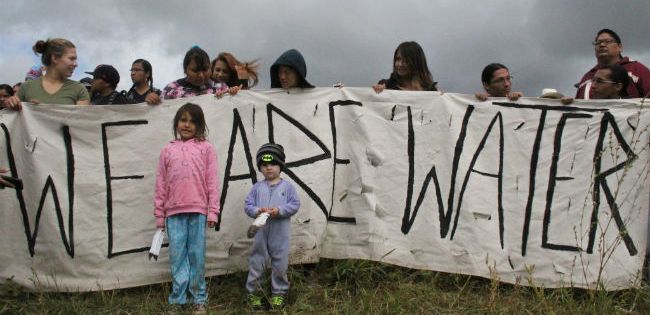
On the front lines of stopping the Dakota Access Pipeline, August, 2016. (D. Kane)
On this day, 153 years ago [September 3, 1863], my
great-great-grandmother
Nape Hote Win (Mary Big Moccasin) survived the bloodiest conflict
between the Sioux Nations and the U.S. Army ever on North Dakota
soil. An estimated 300 to 400 of our people were killed in the
Inyan Ska (Whitestone) Massacre, far more than at Wounded Knee.
But very few know the story.
As we struggle for our lives today against the Dakota
Access Pipeline, I remember her. We cannot forget our stories of
survival.
Just 50 miles [80 kilometres] east of here, in 1863,
nearly 4,000
Yanktonais,
Isanti (Santee), and Hunkpapa gathered alongside a lake in
southeastern North Dakota, near present-day Ellendale, for an
intertribal buffalo hunt to prepare for winter. It was a time of
celebration and ceremony -- a time to pray for the coming year,
meet relatives, arrange marriages, and make plans for winter
camps. Many refugees from the 1862 uprising in Minnesota, mostly
women and children, had been taken in as family. Mary's father,
Oyate Tawa, was one of the 38 Dah'kotah hanged in Mankato,
Minesota, less than a year earlier, in the largest mass execution
in the country's history. Brigadier General Alfred Sully and
soldiers came to Dakota Territory looking for the Santee who had
fled the uprising. This was part of a broader U.S. military
expedition to promote white settlement in the eastern Dakotas and
protect access to the Montana gold fields via the Missouri
River.
As my great-great-grandmother Mary Big Moccasin told
the
story, the attack came the day after the big hunt, when spirits
were high. The sun was setting and everyone was sharing an
evening meal when Sully's soldiers surrounded the camp on
Whitestone Hill. In the chaos that ensued, people tied their
children to their horses and dogs and fled. Mary was 9 years old.
As she ran, she was shot in the hip and went down. She laid there
until morning, when a soldier found her. As he loaded her into a
wagon, she heard her relatives moaning and crying on the
battlefield. She was taken to a prisoner of war camp in Crow
Creek where she stayed until her release in 1870.
Where the Cannonball River joins the Missouri River, at
the
site of our camp today to stop the Dakota Access Pipeline, there
used to be a whirlpool that created large, spherical sandstone
formations. The river's true name is Inyan Wakangapi Wakpa, River
that Makes the Sacred Stones, and we have named the site of our
resistance on my family's land the Sacred Stone Camp. The stones
are not created anymore, ever since the U.S. Army Corps of
Engineers dredged the mouth of the Cannonball River and flooded
the area in the late 1950s as they finished the Oahe dam. They
killed a portion of our sacred river.
I was a young girl when the floods came and desecrated
our
burial sites and Sundance grounds. Our people are in that
water.
This river holds the story of my entire life.
I remember hauling our water from it in big milk jugs
on our
horses. I remember the excitement each time my uncle would wrap
his body in cloth and climb the trees on the river's banks to
pull out a honeycomb for the family -- our only source of sugar. Now
the river water is no longer safe to drink. What kind of world do
we live in?
Look north and east now, toward the construction sites
where
they plan to drill under the Missouri River any day now, and you
can see the old Sundance grounds, burial grounds, and Arikara
village sites that the pipeline would destroy. Below the cliffs
you can see the remnants of the place that made our sacred
stones.
Of the 380 archeological sites that face desecration
along
the entire pipeline route, from North Dakota to Illinois, 26 of
them are right here at the confluence of these two rivers. It is
a historic trading ground, a place held sacred not only by the
Sioux Nations, but also the Arikara, the Mandan, and the Northern
Cheyenne.
Again, it is the U.S. Army Corps that is allowing these
sites
to be destroyed.
The U.S. government is wiping out our most important
cultural
and spiritual areas. And as it erases our footprint from the
world, it erases us as a people. These sites must be protected,
or our world will end, it is that simple. Our young people have a
right to know who they are. They have a right to language, to
culture, to tradition. The way they learn these things is through
connection to our lands and our history.
If we allow an oil company to dig through and destroy
our
histories, our ancestors, our hearts and souls as a people, is
that not genocide?
Today, on this same sacred land, over 100 tribes have
come
together to stand in prayer and solidarity in defiance of the
black snake. And more keep coming. This is the first gathering of
the Océti Sakówin (Sioux tribes) since the Battle of the
Greasy
Grass (Battle of Little Bighorn) 140 years ago. When we first
established the Sacred Stone Camp on April 1 to stop the pipeline
through prayer and non-violent direct action, I did not know what
would happen. But our prayers were answered.
We must remember we are part of a larger story. We are
still
here. We are still fighting for our lives, 153 years after my
great-great-grandmother Mary watched as our people were
senselessly murdered. We should not have to fight so hard to
survive on our own lands.
My father is buried at the top of the hill, overlooking
our
camp on the riverbank below. My son is buried there, too. Two
years ago, when Dakota Access first came, I looked at the
pipeline map and knew that my entire world was in danger. If we
allow this pipeline, we will lose everything.
We are the river, and the river is us. We have no
choice but
to stand up.
Today, we honor all those who died or lost loved ones
in the
massacre on Whitestone Hill. Today, we honor all those who have
survived centuries of struggle. Today, we stand together in
prayer to demand a future for our people.

We Are Protectors, Defending the Land And Water
- Iyuskin American Horse, Canyon Ball,
North
Dakota -
Our elders have told us that if the zuzeca sape, the
black
snake, comes across our land, our world will end. Zuzeca has come -- in
the form of the Dakota Access Pipeline -- and so I must
fight.
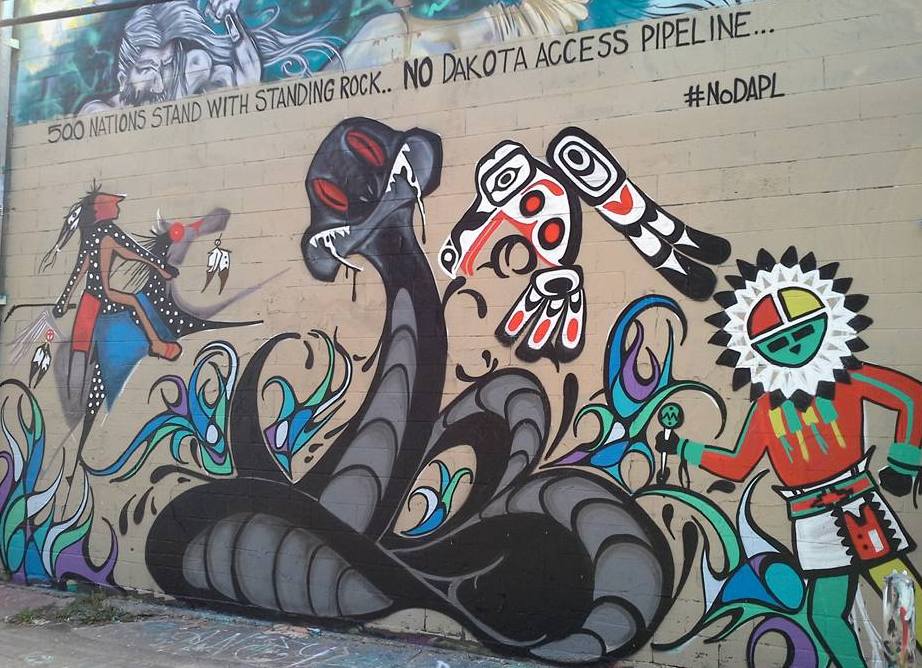 I am Sicangu/Oglala Lakota,
born in Rosebud, South
Dakota,
and writing from the frontline of the movement against the
pipeline in Cannon Ball. I have been holding this ground with my
Standing Rock Sioux tribe relatives since the spring. I am
defending the land and water of my people, as my ancestors did
before me. I am Sicangu/Oglala Lakota,
born in Rosebud, South
Dakota,
and writing from the frontline of the movement against the
pipeline in Cannon Ball. I have been holding this ground with my
Standing Rock Sioux tribe relatives since the spring. I am
defending the land and water of my people, as my ancestors did
before me.
The $3.8bn pipeline project is proposed to carry
approximately 470,000 barrels per day of fracked oil from our
Bakken oil fields, 1,172 miles [1,885 kilometres] through the country's
heartland,
to Illinois. The pipeline will cross the confluence of the
Cannonball and Missouri rivers, where it threatens to contaminate
our primary source of drinking water and damage the bordering
Indigenous burial grounds, historic villages and sundance sites
that surround the area in all directions. Those sites that were
not desecrated when the area was flooded in 1948 by the
construction of the Oahe dam are now in danger again.
I have seen where their machines clawed through the
earth
that once held my relatives' villages.
This week, I have witnessed pipeline construction tear
its
way toward the waters of the Missouri river which flow into the
Mississippi, threatening to pollute the aquifer that carries
drinking water to 10 million people. I have seen where their
machines clawed through the earth that once held my relatives'
villages. I have watched law enforcement officials protect the
oil industry by dragging away my Indigenous brothers and sisters
who stood up for our people.
The fact that Energy Transfer Partners, the company
behind
the pipeline, would use the word "Dakota," which means "friend"
or "ally," in the name of its project is disrespectful. This
pipeline is a direct threat to all Dakota, Lakota and Nakota
people, especially our future generations. And we are not the
only ones. We know that burning this oil is changing our climate
and Indigenous people all over the world are bearing the brunt of
the catastrophes that causes.
This pipeline poses threats strikingly similar to those
posed
by the now defeated Keystone XL, but has received a fraction of
the attention from mainstream media and big environmental groups.
On July 26, we were surprised to learn that the North Dakota
permits were approved by the U.S. Army Corps of Engineers to run
the pipeline within a half-mile of our reservation. My tribal
leaders have said that this was done without consulting tribal
governments, and without a meaningful study of the impacts it
will have. This is a violation of federal law and, more
importantly, of our treaties with the U.S. government -- the supreme
law of the land.
It was my Ina, my mother, who first told me of this
struggle.
With my Ina, ciye (older brother), and tunwin (aunt) we have
joined our Standing Rock relatives to face this new storm. For
the past month, we have stood with Standing Rock in solidarity,
we have prayed, we have cried, and we have also laughed, even
when we thought it impossible to do so.
I never thought I would be on the frontline of a fight
like
this. I grew up admiring Crazy Horse, Sitting Bull, and my
ancestor American Horse, for their courage and leadership in
battle against their oppressors. Now I am fighting alongside
their descendants, my relatives from all seven tribes, against
the very same oppressors.
It saddens me that the government time and time again
continues to ravage my people with the same treatment and
attitude, only different weapons. But why should [we] be surprised?
This is the definition of insanity -- to go through the same
situations over and over believing the outcome will be
different.
This camp was created as a last defense for the water
that
our communities depend on to survive. I have watched our numbers
dwindle down to the single digits, and now we have swelled to
over 300 people in just a few days. Hundreds more are on the way
right now, as other tribes gather resources to send people and
supplies.
This historic battle is bringing the Océti
Sakówin
together
like nothing has ever before. The Hunkpapa, the tribal band of
Standing Rock, are now joined by the Oglala from Pine Ridge, the
Sicangu from Rosebud, and relatives from Crow Creek, Cheyenne
River, and Yankton, as well as Dine and Ponca relatives from the
south, Ojibwe relatives from the Great Lakes, and countless
others. From all across the country, tribes are bringing us
shelter, food and most importantly, prayers.
To have all this unity of tribes standing together in
solidarity before my eyes is a beautiful sight. Our tribes now
live together, eat together, and pray together on the front
lines.
We are not protesters. We are protectors. We are
peacefully
defending our land and our ways of life. We are standing together
in prayer, and fighting for what is right. We are making history
here. We invite you to stand with us in defiance of the black
snake.

The Vicious Dogs of Manifest Destiny
Resurface in North
Dakota
- Jacqueline Keeler -
Private corporate mercenaries hired by Energy Transfer
Partners sicced attack dogs upon a crowd of Native Americans and
their allies, including children, on September 3 who were
nonviolently trying to stop the desecration of sacred burial
grounds and culturally significant archaeological sites by the
company constructing the Dakota Access Pipeline. Six people were
bitten, including one child and a pregnant woman, while 30 were
also maced by the security team.
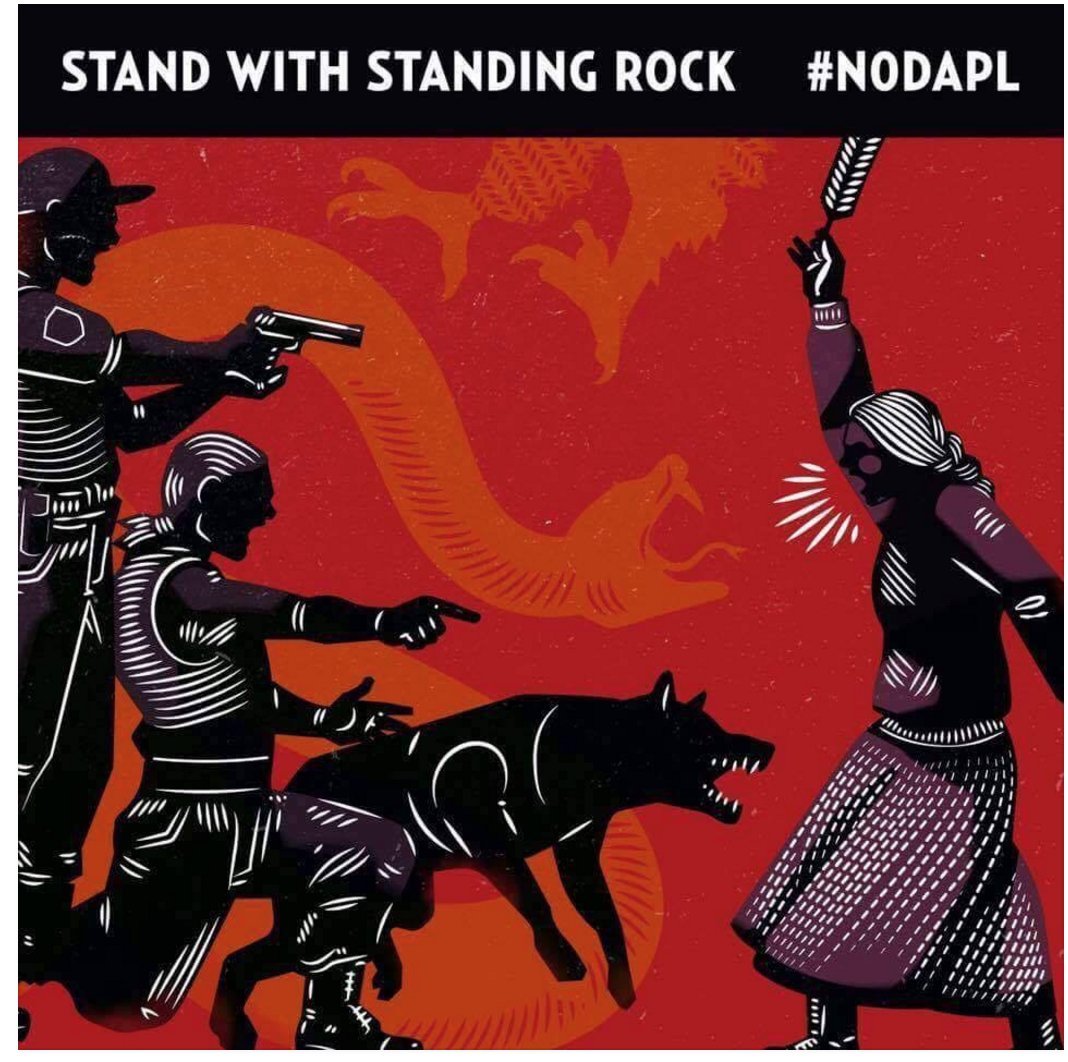 The gathering of water
protectors was estimated at 300,
assembled after the pipeline construction crew abruptly moved
three bulldozers to a site nearly 15 miles [24 kilometres] away -- a
site
identified the day before by Standing Rock Sioux Tribe's historic
preservation officer as containing important cultural and historical
sites. The gathering of water
protectors was estimated at 300,
assembled after the pipeline construction crew abruptly moved
three bulldozers to a site nearly 15 miles [24 kilometres] away -- a
site
identified the day before by Standing Rock Sioux Tribe's historic
preservation officer as containing important cultural and historical
sites.
Native American human remains were most likely
disturbed by
Dakota pipeline workers -- a federal crime. The site is on private
land and the Tribe had received permission from the landowner to
inspect the area adjacent to the pipeline corridor. Texas-based
Energy Transfer Partners, in an apparent attempt to avoid a legal
challenge, may have acted preemptively to destroy the historic
value of the site before a judge could rule on the evidence.
It was a brutal and vicious act.
The land, adjacent to the reservation's northern
border, is
within the treaty territory of the Tribe under the 1868 Treaty of
Fort Laramie and the Tribe retains legal claims to historical
sites there.
"They wanted to destroy the proof and evidence; the
company
knew those sites were there," Standing Rock Sioux Tribal chairman
Dave Archambault told the Bismarck
Tribune. "They don't normally
work on Saturday and Sunday; we know because we've been watching
them. They desecrated all the land where the landowner gave us
permission to look."
In response, the Obama administration took immediate
action
on Labor Day and issued a temporary restraining order against
Dakota Access Pipeline construction, noting concerns about the
oil company "engaging with or antagonizing" the #NoDAPL resistors
warranted a restraining order. This is the first comment of any
kind on the situation given by the administration and President
Barack Obama has been notably silent on this matter, despite the
protest going on since April 1.
In 2014, Obama visited the very site of the
encampment,
Cannonball, North Dakota and promised the Standing Rock Sioux
Tribe he would be a president who "respects your sovereignty, and
upholds treaty obligations, and who works with you in a spirit of
true partnership, in mutual respect, to give our children the
future that they deserve."
 Many have called upon Obama
to honor these promises via
social media and even tribal council resolutions, and apparently
the video and photos of private security dogs with peaceful
protesters' blood in their mouths finally spurred the
administration to some action. Many have called upon Obama
to honor these promises via
social media and even tribal council resolutions, and apparently
the video and photos of private security dogs with peaceful
protesters' blood in their mouths finally spurred the
administration to some action.
And what does it mean when the state or state-backed
corporate conquistadors use dogs and violence to suppress the
will of the people peacefully expressed? For many, the brutality
of Energy Trust Partner's hired security forces, with law
enforcement's tacit support and given favorable coverage by the
mainstream media, is a sign that this pipeline is yet another
example of the forced occupation of Océti Sakówin (the
Great
Sioux Nation) lands.
"Dakota is our name -- it means allies, friends," Faith
Spotted
Eagle, Ihanktonwan elder and founder of the Brave Heart Society
who has been camping at the Océti Sakówin camp at
Cannonball to
oppose the pipeline told TeleSUR. "How can they use it for their
pipeline? They are not being allies to us or to our Mother
Earth."
The malicious use of dogs on the people, the allies,
the true
Dakota, simply underscores the impunity of the corporate power to
use other peoples' lands as they see fit with little or no regard
for the well-being of people or nations.
The use of violence in the service of American
domination has
a bloody and well-remembered history among the Dakota/Lakota
people of the Great Plains and Minnesota. In 1863, the Dakota
rose up as their treaty provisions were denied and their children
were starving in what is called the Minnesota Sioux Uprising.
They were quickly put down and 4,000 fled to join their relatives
among the Dakota and Lakota and Nakota bands in the Dakotas and
in Canada. Thirty-eight Dakota men were hung by President Lincoln
in the largest mass hanging in U.S. history in Mankato,
Minnesota.
And this latest assault with dogs by an oil company on
Océti
Sakówin and their allies takes place exactly 153 years to the
day
since the Whitestone Massacre which occurred on September 3, 1863
not far from the present day protest at Cannonball, North
Dakota.
In an article for Yes! Magazine, Brave Bull
Allard
recalls what her great-great grandmother, Mary Big Moccasin, a
Santee survivor of that violent attack (Big Moccasin's father was
one of the 38 hung at Mankato) remembered about that day:
"The attack came the day after the big hunt, when
spirits
were high. The sun was setting and everyone was sharing an
evening meal when (Colonel) Sully's soldiers surrounded the camp
on Whitestone Hill. In the chaos that ensued, people tied their
children to their horses and dogs and fled. Mary was 9 years old.
As she ran, she was shot in the hip and went down. She laid there
until morning, when a soldier found her. As he loaded her into a
wagon, she heard her relatives moaning and crying on the
battlefield. She was taken to a prisoner of war camp."
This history of violence begs the question, what was
Manifest
Destiny? What was the United States of America built on? Is it
this genocide and impunity, this belief that everything here,
everything belonging to the nations of people that already were
here, even their very lives, are free for the taking? Has
everyone who came to America come here to partake in this
barbarism?
I compare this to the terms my Dakota ancestors used to
describe themselves. Dakota, allies/friends versus Dakota
Access -- which clearly means access to everything that belongs to
us, a latter-day Manifest Destiny, a latter-day expression of
this genocidal impunity. And to another term, Ikce Wicasa,
variously interpreted as "free" and "humble people." It may seem
odd that a people known around the world by the exploits of
Sitting Bull and Crazy Horse would think of themselves in those
terms -- indeed regard those terms as the highest terms of humanity
that could be expressed. For them, to be humble was to be truly
free. To be allied with each other to preserve the lives, their
relationship to the each other and to the Earth was what it meant
to be human.
I can't help but compare Ikce Wicasa to the term
"Pioneer"
which is derived from the French term for peons, lower class
folks who were considered expendable and sent ahead of the
regular army as cannon fodder. And I remember the story recorded
by my great-great aunt Ella Deloria, a Yankton Dakota ethnologist
from elders she interviewed 100 years ago, of how the railroad
once dumped white people off in North Dakota with nothing but a
box to live in. They were left along railroad lines to act as a
buffer between the railroad and the "Indians." Ironically, it was
our people that often had to come to their aid because they were
basically left to starve by those railroad tycoons.
There was a term in our language my Lala (grandfather)
once
told me that meant "that which looks human but is not" and when I
look at a photo taken of Energy Transfer Partner's CEO Kelcy
Warren watching a #NoDAPL protest outside his Texas corporate
offices on Friday [September 2] smirking the day before he ordered dogs
to bite
Native Americans and even children and pregnant women, I can't
help but wish I remembered what that word was.
Because that is what he is.
Jacqueline Keeler is a Navajo/Yankton Dakota Sioux
writer
living in Portland, Oregon. She has been published in Salon,
Indian Country Today, Earth Island Journal and the Nation. She is
finishing her first novel "Leaving the Glittering World" set in
the shadow of the Hanford Nuclear Reservation in Washington State
during the discovery of Kennewick Man.

PREVIOUS
ISSUES | HOME
Website: www.cpcml.ca
Email: editor@cpcml.ca
|









 I am Sicangu/Oglala Lakota,
born in Rosebud, South
Dakota,
and writing from the frontline of the movement against the
pipeline in Cannon Ball. I have been holding this ground with my
Standing Rock Sioux tribe relatives since the spring. I am
defending the land and water of my people, as my ancestors did
before me.
I am Sicangu/Oglala Lakota,
born in Rosebud, South
Dakota,
and writing from the frontline of the movement against the
pipeline in Cannon Ball. I have been holding this ground with my
Standing Rock Sioux tribe relatives since the spring. I am
defending the land and water of my people, as my ancestors did
before me. The gathering of water
protectors was estimated at 300,
assembled after the pipeline construction crew abruptly moved
three bulldozers to a site nearly 15 miles [24 kilometres] away -- a
site
identified the day before by Standing Rock Sioux Tribe's historic
preservation officer as containing important cultural and historical
sites.
The gathering of water
protectors was estimated at 300,
assembled after the pipeline construction crew abruptly moved
three bulldozers to a site nearly 15 miles [24 kilometres] away -- a
site
identified the day before by Standing Rock Sioux Tribe's historic
preservation officer as containing important cultural and historical
sites. Many have called upon Obama
to honor these promises via
social media and even tribal council resolutions, and apparently
the video and photos of private security dogs with peaceful
protesters' blood in their mouths finally spurred the
administration to some action.
Many have called upon Obama
to honor these promises via
social media and even tribal council resolutions, and apparently
the video and photos of private security dogs with peaceful
protesters' blood in their mouths finally spurred the
administration to some action.